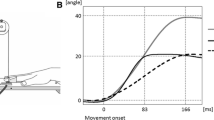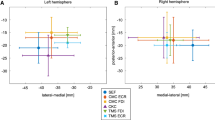Abstract
Neuromagnetic fields from the left cerebral hemisphere of five healthy, right-handed subjects were investigated under three different experimental conditions: (1) electrical stimulation of the right index finger (task S); (2) voluntary movement of the same finger (M); (3) M+S condition, consisting of voluntary movements of the right index finger triggering the electrical stimulus at the very beginning of the electromyogram. The three conditions were administered in random order every 5–8 s. In addition, the task somatosensory evoked fields (task SEFs) gathered during condition (1) were compared with control SEFs recorded at the beginning of the experiment during rest. In all subjects the overlay of somatosensory stimulation on movement provoked a decrement in brain responsiveness (gating) as determined by the amplitude of gated SEFs. The latter was found as the difference between the neuromagnetic fields during M+S condition (overlaying of movement and sensory stimulation) minus neuromagnetic fields under M condition (M only). The gating effect was found to begin approximately 30 ms after movement onset, and to last for the whole period of the ongoing movement. The theoretical locus of gating was estimated by dipole localisation of the difference between task SEFs and gated SEFS using a moving dipole model. The site of the “early” gating effect (<40 ms) was found to be more anteriorly located than the “later” (>40 ms) gating effect. The task SEFs were found to be larger (significant after 30 ms) than the control SEFs elicited under the basal condition. The results are discussed with respect to timing, mechanism (centrifugal and centripetal), locus and selectivity of gating. In addition, the results are discussed with regard to clinical application (measuring attentional deficits in patients with impairments of higher mental functions and measuring gating deficits in patients with disturbed sensorimotor integration).
Similar content being viewed by others
References
Adey WR, Noda H (1963) Influence of eye movements on geniculate excitability in the cat. J Physiol (Lond) 235: 805–821
Angel RW, Boylls CG, Weinrich M (1984) Cerebral evoked potentials and somatosensory perception. Neurology 34: 123–126
Angel RW, Weinrich M, Rodnitzky R (1986) Recovery of somatosensory evoked potential amplitude after movement. Ann Neurol 19: 344–348
Baumgartner C, Doppelbauer A, Deecke L, Barth D, Zeitlhofer J, Lindinger G, Sutherling W (1991) Neuromagnetic investigation of somatotopy of human hand somatosensory cortex. Exp Brain Res 87: 641–648
Cheron G, Borenstein S (1987) Specific gating of the early somatosensory evoked potentials during active movement. Electroencephalogr Clin Neurophysiol 67: 537–548
Cheron G, Borenstein S (1991) Gating of the early components of the frontal and parietal somatosensory evoked potentials in different sensory-motor interference modalities. Electroencephalogr Clin Neurophysiol 80: 522–530
Cheron G, Borenstein S (1992) Mental movement simulation affects the N30 frontal component of the somatosensory evoked potentials. Electroencephalogr Clin Neurophysiol 84: 288–298
Cheyne D, Weinberg H (1989) Neuromagnetic fields associated with unilateral finger flexions: premovement and movementevoked fields. Exp Brain Res 78: 604–612
Cohen LG, Starr A (1987) Localisation, timing and specificity of gating of somatosensory evoked potentials during active movement in man. Brain 110: 451–467
Desmedt JE, Cheron G (1981) Non-cephalic reference recording of early SEP to finger stimulation in adult or aging man: differentiation of widespread N18 and contralateral N20 from the prerolandic P22 and N30 components. Electroencephalogr Clin Neurophysiol 52: 553–570
Desmedt JE, Nguyen TH, Bourguet M (1987) Bit-mapped color imaging of human evoked potentials with reference to the N20, P22, P27 and N30 somatosensory responses. Electroencephalogr Clin Neurophysiol 68: 1–19
Fetz EE, Finocchio DN, Baker MA, Soso MJ (1980) Sensory and motor responses of precentral cortex cells during comparable passive and active joint movements. J Neurophysiol 42: 1070–1089
Foglietti V, Del Gratta C, Pasquarelli A, Pizzella V, Torrioli G, Romani GL, Gallagher WJ, Ketchen MB, Kleinsasser AW, Sandstrom RL (1991) 28-channel hybrid system for neuromagnetic measurements. IEEE Trans Magn 27: 2959–2962
Garcia-Larrea L, Batsuji H, Mauguiere F (1991) Mapping study of somatosensory evoked potentials during selective spatial attention. Electroencephalogr Clin Neurophysiol 80: 201–214
Hallett M (1993) Physiology of basal ganglia disorders: an overview. Can J Neurol Sci 20: 177–183
Hari R, Karhu J, Hämäläinen M, Knuutila J, Salonen O, Sams M, Vilkman V (1994) Functional organization of the human first and second somatosensory cortices: a neuromagnetic study. Eur J Neurosci 5: 724–734
Jones SJ (1981) An interference approach to the study of somatosensory evoked potentials in man. Electroencephalogr Clin Neurophysiol 52: 517–530
Jones EG (1983) The nature of the afferent pathways conveying short-latency inputs to primate motor cortex. In: JE Desmedt (ed) Motor control mechanism in health and disease. Raven Press, New York, pp 263–285
Jones EG, Coulter JD, Hendry SHC (1978) Intracortical connectivity of architectonic fields in the somatic sensory, motor and parietal cortex of monkeys. J Comp Neurol 181: 291–348
Jones SJ, Halonen JP, Shawkat F (1989) Centrifugal and centripetal mechanisms involved in the gating of cortical SEPs during movement. Electroencephalogr Clin Neurophysiol 74: 36–45
Kakigi R (1995) Somatosensory evoked magnetic fields following median nerve stimulation. Neurosci Res 20: 165–174
Kornhuber HH, Deecke L (1965) Hirrnpotentialänderungen bei Willkürbewegungen und passiven Bewegungen des Menschen: Bereitschaftpotential und reafferente Potentiale. Pflugers Arch 284: 1–17
Kristeva R (1984) Bereitschaftpotential of pianists. Ann NY Acad Sci 425: 477–482
Kristeva R, Cheyne D, Deecke L (1991) Neuromagnetic fields accompanying unilateral and bilateral voluntary movements: topography and analysis of cortical sources. Electroencephalogr Clin Neurophysiol 81: 284–298
Kristeva-Feige R, Walter H, Lütkenhöner B, Hampson S, Ross B, Knorr U, Steinmetz H, Cheyne D (1994) A neuromagnetic study of the functional organization of the sensorimotor cortex. Eur J Neurosci 6: 632–639
Kristeva-Feige R, Rossi S, Pizzella V, Tecchio F, Romani GL, Erne S, Edrich J, Orlacchio A, Rossini PM (1995) Neuromagnetic fields of the brain evoked by voluntary movement and electrical stimulation of the index finger. Brain Res 682: 22–28
Lee RG, White DG (1974) Modification of somatosensory evoked potentials during movements. Electroencephalogr Clin Neurophysiol 36: 53–62
Mauguiere F, Desmedt JE, Courjon J (1983) Astereognosis and dissociated loss of frontal or parietal components of somatosensory evoked potentials in hemispheric lesions: detailed correlations with clinical signs and computerized tomographic scanning. Brain 106: 271–311
Mauguiere F, Broussolle E, Isnard J (1993) Apomorphine-induced relief of the akinetic-rigid syndrome and early median nerve somatosensory evoked potentials (SEPs) in Parkinson's disease. Electroencephalogr Clin Neurophysiol 88: 243–254
McCloskey DI (1981) Corollary discharges: motor commands and perception. In: Brooks VB (ed) Handbook of physiology: The ervous system, vol 2, part 2. American Physiological Society, Bethesda, Md, pp 1415–1447
Nagamine T, Toro C, Balish M, Deuschl G, Wang B, Sato S, Shibasaki H, Hallett M (1994) Cortical magnetic and electric fields associated with voluntary finger movement. Brain Topogr 6: 175–183
Papakostopoulos D, Cooper R, Crow HJ (1975) Inhibition of cortical evoked potentials and sensation by self-initiated movement in man. Nature 258: 321–324
Romani GL, Rossini PM (1988) Neuromagnetic functional localisation: principles, state of the art and perspectives. Brain Topogr 1: 5–21
Rossini PM, Gigli GL, Marciani MG, Zarola F, Caramia MD (1987) Non-invasive evaluation of input-output characteristics of sensorimotor cerebral areas in healthy humans. Electroencephalogr Clin Neurophysiol 68: 88–100
Rossini PM, Babiloni F, Bernardi G, Cecchi L, Johnson PB, Malentacca A, Stanzione P, Urbano A (1989a) Abnormalities of short-latency somatosensory evoked potentials in parkinsonian patients. Electroencephalogr Clin Neurophysiol 74: 277–289
Rossini PM, Narici L, Romani GL, Peresson M, Torrioli G, Traversa R (1989b) Simultaneous motor output and sensory input: cortical interference site resolved in humans via neuromagnetic measurements. Neurosci Lett 96: 300–305
Rossini PM, Paradiso C, Zarola F, Mariorenzi R, Traversa R, Martino G, Caramia MD (1990) Bit-mapped somatosensory evoked potentials and muscular reflex responses in man: comparative analysis in different experimental protocols. Electroencephalogr Clin Neurophysiol 77: 266–276
Rossini PM, Paradiso C, Zarola F, Bernardi G, Caramia MD, Margari L, Ferrari E (1991) Brain excitability and long latency muscular arm responses: non-invasive evaluation in healthy and Parkinsonian subjects. Electroencephalogr Clin Neurophysiol 81: 454–465
Rossini PM, Caramia MD, Bassetti A, Pasqualetti P, Tecchio F, Bernardi G (1995) Somatosensory evoked potentials during the ideation and execution of individual finger movements folowing “internal” or “external” cues. Muscle Nerve (in press)
Rushton DN, Rothwell JC, Craggs MD (1981) Gating of somatosensory evoked potentials during different kinds of movements in man. Brain 104: 465–491
Seyal M, Orstad JL, Louis W, Kraft BS, Gabor AJ (1987) Effect of movement on human spinal and subcortical somatosensory evoked potentials. Neurology 37: 650–655
Soso MJ, Fetz EE (1980) Responses of identified cells in postcentral cortex of awake monkeys during comparable active and passive joint movements. J Neurophysiol 43: 1090–1109
Sperry RW (1950) Neural basis of the spontaneous optokinetic response produced by visual neural inversion. J Comp Physiol Psychol 43: 482–489
Tapia MC, Cohen LG, Starr A (1987) Selectivity of attenuation (i.e.gating) of somatosensory potentials during voluntary movement in humans. Electroencephalogr Clin Neurophysiol 68: 226–230
Taylor MJ (1978) Bereitschaftpotential during the acquisition of a skilled motor task. Electroencephalogr Clin Neurophysiol 45: 568–576
Williamson SJ, Kaufman L (1981) Biomagnetism. J Magn Magn Mat 22: 129–201
Author information
Authors and Affiliations
Rights and permissions
About this article
Cite this article
Kristeva-Feige, R., Rossi, S., Pizzella, V. et al. A neuromagnetic study of movement-related somatosensory gating in the human brain. Exp Brain Res 107, 504–514 (1996). https://doi.org/10.1007/BF00230430
Received:
Accepted:
Issue Date:
DOI: https://doi.org/10.1007/BF00230430




